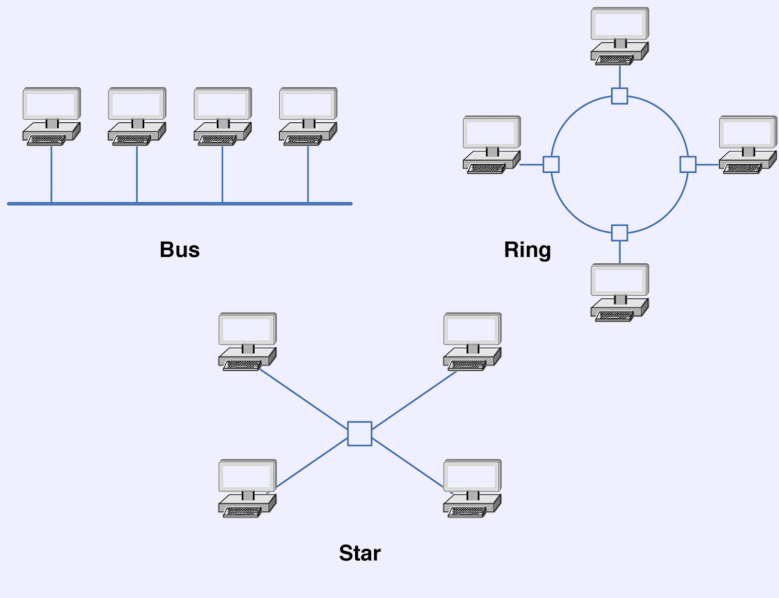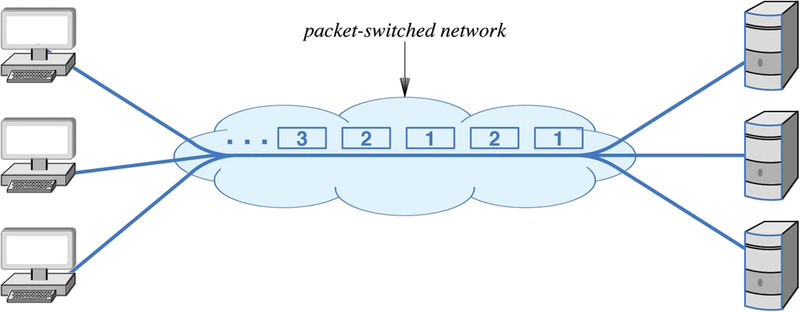Material from Chapters 13.
- Network Classifications
- Local Area Network (LAN). Single room, building, or campus.
- Wide Area Network (WAN). State or region up to the whole world.
- Metropolitan Area Network (MAN). Span a city. Seem to exist mostly just in theory.
- Local Area Network (LAN). Single room, building, or campus.
- This section is about LANs.
- Connecting each computer point-to-point would be too expensive.
- Connecting n computers requies (n2−n)/2 links.
- Use shared connections.
- LAN Topologies.
- Bus describes the original Ethernet. Current versions are essentially stars. Messages sent on the bus are delivered to all stations.
- Wired ring nets are not longer used, but many optical LANs use a ring. Messages travel once around the circle and are removed by the sender.
- Messages go to the hub, which send them out to some or all of the nodes.

- Packet switching.
- As in other digital networking, LANs send data in packets.

- A way of sharing a channel. Any sender may send a packet when the channel is available.
- Receivers can check each packet as it arrives.
- As in other digital networking, LANs send data in packets.
- Standards Body
- Application Layer: World-Wide Web Consortium (W3C), Web Hypertext Application Technology Working Group (WHATWG), sometimes Internet Engineering Taskforce (IETF).
- Transport, Internet: Internet Engineering Taskforce (IETF).
- Physical: Institute of Electrical and Electronics Engineers (IEEE).
- This section is in IEEE territory. IEEE LAN standards. Among many:
- 802.3 CSMA/CD (Ethernet)
- 802.5 Token Ring
- 802.11 Wireless LAN (WiFi)
- 802.15 Wirless PAN.
- 802.16 Wireless Broadband
- IEEE does not seem to standardize the optical net standards.
- Frames
- Prelude (optional) contains known patterns for synchronization and marking the start of the frame.
- Header contains addressing and possibly error check or correction data.
- Payload is the actual data.
- Check is optional. Often the check is at the end to allow the endpoint to compute it as the message is flowing in or out.
- Postlude (optional) for marking the frame end, or checking timing.

- Frame Marking
- Frames boundaries often marked by special bytes.
- This requires escaping when these values are needed in the frame.

- Called byte stuffing.
- Some optical nets use 4B/5B coding.
- Each five-bit unit of transmission codes either control or four bits of data.
- For instance:
Code Meaning 01101 T Control (Part of end delimiter) 01110 Data 0110 01111 Data 0111 10000 Unused 10001 K Control (Part of start delimiter) 10010 Data 1000 - So no escaping needed.
- IEEE LAN standards cover two main aspects
- Logical Link Control (LLC)
- How to address individual hosts.
- How to direct the payload within the receiving host.
- Media Access Control (MAC): How to share the medium in an orderly way.
- Logical Link Control (LLC)